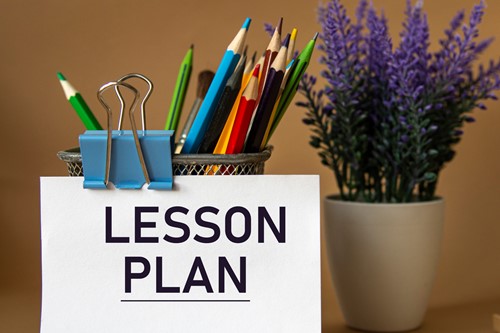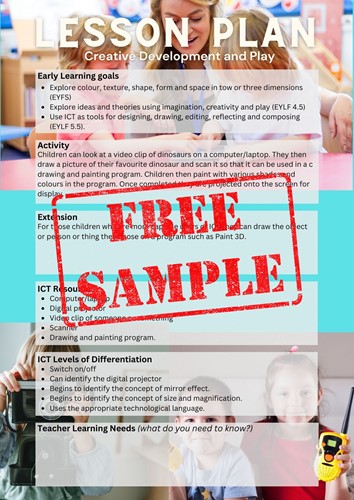
Curriculum-aligned digital learning ideas for early years educators
When you're planning ICT activities for students, especially in kindergarten, the challenge is often finding meaningful, hands-on learning that also aligns with curriculum outcomes. That’s where the ICT in Education Teacher Academy helps—providing access to developmentally appropriate, Australian Curriculum-aligned lesson plans that are easy to implement and professionally enriching.
Here are 10 ICT activities for kindergarten educators that integrate EYLF outcomes, encourage purposeful play, and show how membership transforms these ideas into strategic teaching tools.
1. Learning About Computers
Activity Description:
Children explore basic computer parts like the monitor, keyboard, and mouse using hands-on activities on laptops or tablets. They practice typing their names, drawing with a mouse, or interacting with digital storybooks.
Membership Connection:
This foundational activity becomes a professional growth tool through the membership's observation templates and planning guides. Members use the workbook to identify EYLF 4.4 and 3.2 outcomes, then reflect using prompts that build Technological Knowledge (TK).
2. Outdoor Digital Storytelling
Activity Description:
Children use tablets to record sounds in nature—rustling leaves, chirping birds—then combine them with voice recordings and drawings to narrate their own stories using Book Creator or iMovie.
Membership Connection:
Members receive step-by-step guides and reflection prompts to extend this from an outdoor activity into a multimodal learning experience. The membership’s community forum often shares variations on this lesson across different contexts.
3. QR Code Nature Hunt
Activity Description:
Children scan QR codes placed around the yard or garden. Each code links to a fun fact about nature—plants, bugs, or the weather. Children reflect through drawing or storytelling.
Quick-Start Tip: Create simple QR codes using a free generator and print them out.
Membership Connection:
This activity is mapped in the Members’ Library’s Outdoor Learning Playlist. Members gain ready-made QR sheets and digital storytelling prompts to deepen the experience with professional reflection tools.
4. Taking Apart a Computer
Activity Description:
Using a safe, deconstructed desktop, children investigate internal computer parts with toy tools. They discuss how computers work and where they’ve seen them before.
Quick-Start Tip: Ask families or your school if a broken tower is available—no software needed.
Membership Connection:
The workbook helps educators link this hands-on task with EYLF 4.5 and 5.5 while tracking observations that show problem-solving growth. Members often share photos of similar setups in the community forum.
5. Drawing with Programmable Toys
Activity Description:
Attach markers to a Bee Bot and have children code movements that result in unique abstract art patterns.
Quick-Start Tip: Start with just one Bee Bot, a marker, and a sheet of cardboard.
Membership Connection:
Members access planning templates that guide progression from basic programming to creative coding exploration. Workbook checklists support tracking movement skills and directionality learning.
6. Bee Bot as a Butterfly
Activity Description:
Children create paper flowers, then program a Bee Bot to “pollinate” them by collecting counters. They learn sequencing while engaging in dramatic play.
Quick-Start Tip: Prep with craft flowers and a floor mat—no extra software required.
Membership Connection:
This activity is featured in the seasonal thematic planning templates inside the membership. Members use APST-aligned tools to align the activity with professional growth goals and Success Path progress.
7. Abstract Art with Bee Bot
Activity Description:
Children take turns programming a Bee Bot with attached coloured markers. They explore creative pattern-making through movement, music, and reflection.
Quick-Start Tip: Have music ready and let children take turns pressing movement buttons.
Membership Connection:
Members use reflection prompts and creativity-based rubrics from the workbook to help children verbalize their digital art process. This lesson is often discussed in the Creative Expression Workshop.
8. Bee Bot School Bus
Activity Description:
Create a pretend city using blocks. Children program a Bee Bot “bus” to pick up toys at different stops, strengthening sequencing and spatial thinking.
Quick-Start Tip: Use any toy figures and arrange books or blocks to form a street path.
Membership Connection:
Inside the membership, this is part of a transport-themed unit. Members follow the Success Path to scaffold coding knowledge and use downloadable mats and observation logs.
9. 2D Shapes – Creating Real World Images
Activity Description:
Children use Paint 3D to draw houses, cars, or people using only shapes. They explore numeracy concepts and practice digital drawing skills.
Quick-Start Tip: Use Paint 3D (or any shape-drawing app). Prompt children to recreate something they know (e.g., house, tree).
Membership Connection:
This lesson supports numeracy outcomes in EYLF 5.4. Members follow workbook pages that align shape learning with creativity and use TPK prompts to enhance teaching reflection.
10. Digital Nature Walk and Photography
Activity Description:
Children explore the outdoors with a tablet or digital camera, capturing natural patterns, textures, and colours. Later, they create collages or slideshows of their findings.
Quick-Start Tip: Head outdoors with tablets and invite children to photograph leaves, flowers, and the sky.
Membership Connection:
This is part of the Academy’s digital science and nature series. Members use the digital collage guide and professional learning log to evaluate and reflect on ICT use across learning areas.
Which One Can You Try Tomorrow?
Looking for the easiest place to start? Here are 3 no-prep activities you can try right away:
-
Learning About Computers – use what you already have: a tablet or laptop
-
Bee Bot Abstract Art – just grab cardboard, markers, and your Bee Bot
-
Digital Photography Nature Walk – head outside with a tablet or phone
Even small steps lead to big progress.
Bringing It All Together
The activities above are just the starting point. With the ICT in Education Teacher Academy, you don’t just get lesson plans—you get a structured, professional development path that:
-
Tracks your growth through the Success Path
-
Gives access to community feedback and differentiated strategies
-
Connects each activity to EYLF outcomes, ICT capabilities, and APST evidence
-
Supports your use of ICT in early learning with purpose—not just play

Supporting ICT Integration in Primary Classrooms
Curriculum-aligned digital learning ideas for early years and Year 1–3 teachers
For primary educators, especially in the early years, finding ICT activities that are not just engaging but curriculum-aligned and developmentally appropriate can be challenging. Whether you’re in Year 1 or planning for Foundation–Year 3, it’s often hard to strike the right balance between play, purpose, and pedagogy.
That’s why the ICT in Education Teacher Academy has developed a library of classroom-ready lesson plans—specifically designed to support ICT activities for primary school learning goals.
These 10 examples below are taken directly from lesson plans available inside the membership. Each one connects ICT to literacy, communication, digital storytelling, and inquiry learning. Best of all, they are simple to implement and structured to help teachers track professional growth as they go.
1. Character Reflections with Word Processors
Activity Description:
Students draft and redraft short imaginative texts using a word processing program (e.g., MS Word). They focus on grammar, spelling, punctuation, and adding headings or images.
Quick-Start Tip: Begin with a paper draft and then move to MS Word, Pages, or Google Docs for digital redrafting.
Membership Connection:
This lesson is part of the Year 1 Literacy with ICT sequence. Members use planning templates to scaffold ICT skills like typing, inserting images, and saving files. Reflection prompts help track growth in literacy and digital capability over timeYear 1 Literacy 1.
2. Informative Text Writing with Digital Tools
Activity Description:
Students use word processors to create informative texts based on classroom research or reading. They add headings, insert images, and explore formatting options like font size or colour.
Quick-Start Tip: Use templates to guide students through structuring their work and inserting visual elements.
Membership Connection:
This lesson links directly to curriculum outcomes for Year 1. Members can assess progress using workbook rubrics that support both ICT capability and literacy developmentYear 1 Literacy 2.
3. Retelling Stories with Digital Storytelling Software
Activity Description:
Students recount key events of a story using MS PowerPoint, Google Slides, or other digital storytelling software. They include personal reflections, captions, and images.
Quick-Start Tip: Provide a story template with space for text and image in each slide.
Membership Connection:
Members use this lesson to introduce presentation tools early in the primary years. Planning tools in the workbook help align storytelling structure with TPACK integration strategiesYear 1 Literacy 3.
4. Sending Emails with Images
Activity Description:
Students learn the basics of email—composing a message, adding a subject line, and attaching an image or document to send to the teacher or another student.
Quick-Start Tip: Use your school’s email platform to create a safe and secure practice task.
Membership Connection:
This activity is enhanced inside the membership with a full digital communication mini-unit. Members follow success path templates to scaffold skills and embed formative assessmentYear 1 Literacy 4.
5. Exposition Writing with Mind Mapping Tools
Activity Description:
Students use Kidspiration or similar software to plan and write an opinion piece (e.g., “Healthy Food in the Canteen”). They organise ideas visually, then draft their exposition using a word processor.
Quick-Start Tip: Have students begin with a print mind map if software is unavailable, then transfer ideas to digital form.
Membership Connection:
This lesson supports students in early stages of creating arguments and organising ideas. Members apply ICT teaching strategies from the workbook to support autonomy and higher-order thinkingYear 1 Literacy 5.
6. News in Images – Media Literacy with Graphics Tools
Activity Description:
Students select a news article without an image and create a related visual using drawing programs or digital photos. They integrate ICT and media literacy through image design.
Quick-Start Tip: Use Paint, Canva, or PowerPoint to create illustrations, then display them alongside printed news clips.
Membership Connection:
Inside the membership, this activity supports communication and critical literacy goals. Members use reflection tools to evaluate student understanding of media messagesYear 1 Literacy 5.
7. Collaborative Book Review Using a Wiki
Activity Description:
Students contribute to a shared book report on a class wiki. They write sections under pre-assigned headings and help edit each other’s content.
Quick-Start Tip: Set up a Google Doc with headings as an alternative if a wiki is not available.
Membership Connection:
Members follow guidance on developing collaborative writing structures. The community forum offers ideas on managing digital collaboration in the early yearsYear 1 Literacy 5.
8. Digital Name Styling with Fonts and Colours
Activity Description:
Students write and creatively style their names using different fonts, sizes, and colours in MS Word or Paint 3D. They compare their designs and discuss visual presentation.
Quick-Start Tip: Print out the final name styles for classroom display or portfolio inclusion.
Membership Connection:
Members use this simple activity to introduce early keyboard and formatting skills. The workbook supports linking this lesson to visual literacy and communication outcomesCreative name writing.
9. Bee Bot Alphabet Navigation
Activity Description:
Using Bee Bots and large alphabet letters, students spell out their names by programming the Bee Bot to move to each letter in the correct sequence.
Quick-Start Tip: Use printed letters on the floor or on a laminated mat and program short paths first.
Membership Connection:
This is a perfect crossover activity from ECE to Year 1. Members use differentiated ICT levels from the workbook to tailor support and extend learning through problem-solvingBEEBOT~1.
10. Digital Narratives with Photos and Video
Activity Description:
Students take digital photos and record short video clips to tell a personal or imaginative story. They upload media into a word processor or slideshow and narrate the scenes.
Quick-Start Tip: Use tablets or iPads with built-in cameras and free drawing or video apps.
Membership Connection:
This lesson supports rich multimodal communication. Members are guided to reflect on language development, media selection, and digital creativity using workbook scaffoldsDigital images, literac….
Why These Activities Matter
These primary-focused lesson plans are more than just classroom tasks—they’re part of a broader professional learning journey. As a member of the ICT in Education Teacher Academy, you’re supported every step of the way:
-
Download lessons that align with curriculum goals
-
Plan, implement, and adapt using the membership workbook
-
Track your growth through the Technology Integrator’s Success Path
-
Create and share your own ICT lessons in the community forum
-
Reflect and lead through digital capability and collaborative practice
From Lesson to Leadership
The journey doesn’t stop at downloading ideas. Members evolve into reflective practitioners—planning, creating, sharing, and leading others in ICT integration. That’s what sets these ict activities for students apart.
From Download to Transformation: Why Successful ICT Integration Starts with the Right Support
Helping educators apply ICT activities in the classroom with confidence and purpose
When it comes to teaching and learning with ICT, most educators aren’t struggling to find ideas—they’re struggling to apply them successfully.
That’s why the ICT in Education Teacher Academy isn’t just a collection of downloadable resources. It’s a professional learning system designed to help early childhood and primary teachers go beyond the worksheet—guiding them from their first download to full transformation in how they teach with technology.
This blog brings together everything we’ve shared in our earlier articles on ICT activities for kindergarten and ICT activities for primary school, and shows how our membership makes those ideas truly work in the classroom.
| WITHOUT MEMBERSHIP | AS A MEMBER OF THE ACADEMY |
|---|---|
| You find ICT activity ideas but don’t know how to adapt them | You access lesson plans + a workbook that guides planning, implementation, and reflection |
| Activities are hit-and-miss depending on tech access | You receive differentiated ICT levels for every lesson (basic to advanced use) |
| Unsure how to track student progress or learning outcomes | You use observation templates aligned to EYLF and APST |
| Limited time to reflect or improve practice | The Success Path helps you log your growth toward confident ICT integration |
| You work alone | The member community offers real-time ideas, feedback, and examples |
What Do Successful ICT Activities in the Classroom Look Like?
As a member, you’re supported to move from simply running an activity to transforming how students engage with technology. Here’s what that journey can look like:
For Kindergarten:
• Learning about computers through play-based mouse and keyboard use
• Programming Bee Bots to create digital artwork or navigate obstacle courses
• Using digital storytelling apps to narrate nature discoveries outdoors
For Primary Students:
• Typing character reflections and inserting images using MS Word
• Sending their first email with an attachment and clear subject line
• Creating a collaborative book review on a shared digital platform
These are not just technology activities for students. They are purposeful, scaffolded, and professionally aligned lessons that help students build ICT capability, not just screen time.
How the Membership Turns Teaching Ideas into Professional Growth
Each time you download and apply a lesson plan from the membership, you take a step forward in your own development. Here’s how:
📘 Best-Suited Workbook Tools for Every Member:
• Lesson Planning Templates – to map goals, outcomes, and ICT levels
• Observation & Reflection Pages – to track student learning and your teaching impact
• Success Path Milestones – to move from Adoption ➝ Adaptation ➝ Infusion ➝ Transformation
• TPACK Radar Chart – to visualise your growth in teaching with technology
• APST-linked Templates – to collect evidence for certification and review
Why Teaching and Learning with ICT Needs More Than a Good Idea
Using ICT activities in the classroom is important—but applying them with intentionality, differentiation, and reflection is what truly transforms teaching.
That’s why members are encouraged not just to use resources, but to:• Plan with purpose using the workbook
• Adapt lessons to suit different learners
• Track their professional growth as they teach
• Share outcomes and receive feedback in the community
• Build toward confident, creative, and curriculum-aligned ICT integration
These blogs have shown you what to teach, how to teach it, and—through the membership—how to become a more confident, capable ICT-integrating educator.

Ready to Make These Activities Work for You?
What’s stopping you from applying ICT with purpose—and progressing toward transformation?

